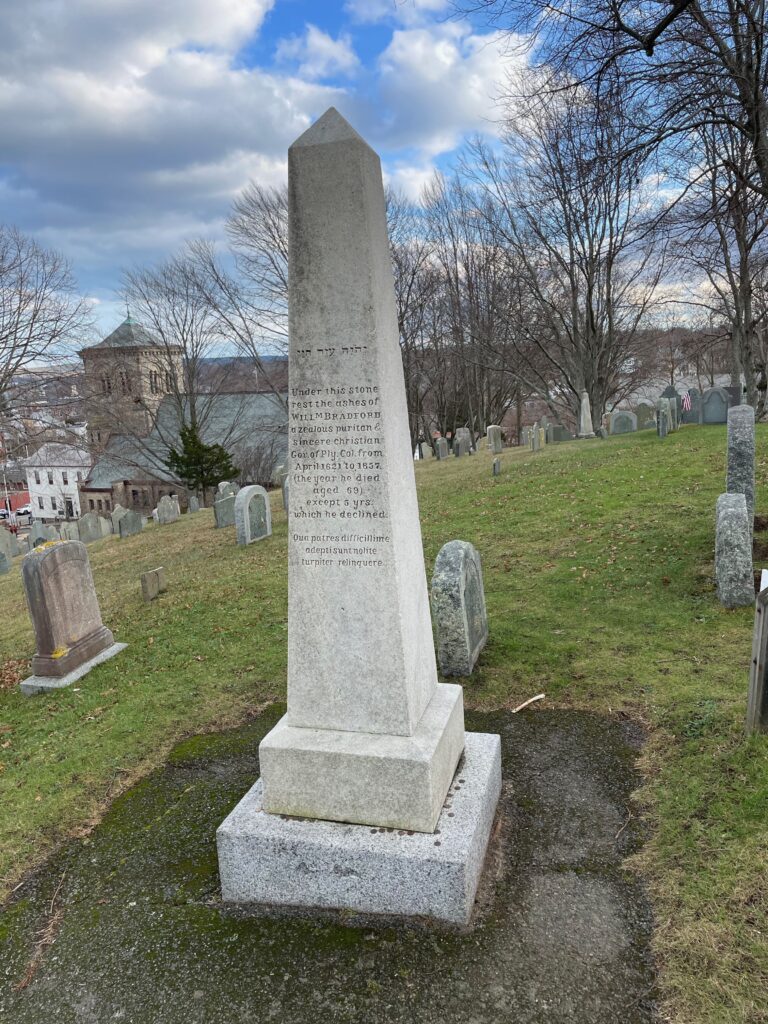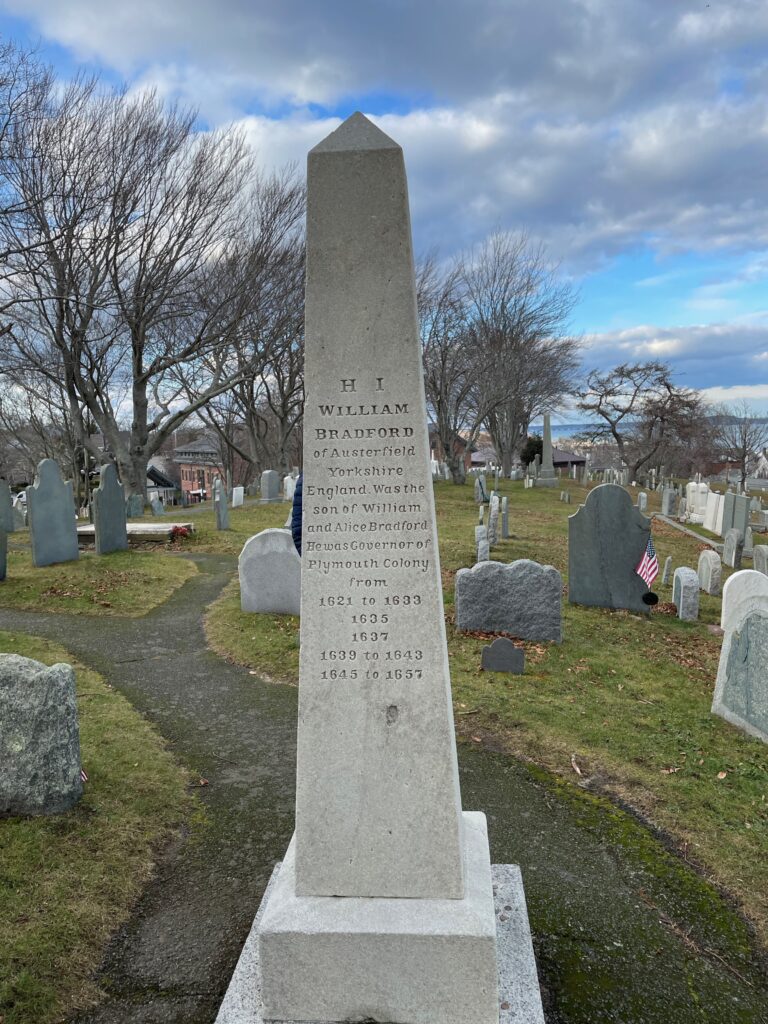Erik Visits an American Grave, Part 1,287
This is the grave of William Bradford.


Born in 1590 in Yorkshire, England, Bradford came from a fairly well off family, with roots back into the limey nobility. But that was a long time ago and the 1590s were no great time in England. Death stalked the door at any time. By the time he was seven, both of his parents and his grandfather had died, so he was sent to live with uncles. He was a sickly child and couldn’t help on the farm so much as he was expected to. He read the Bible instead and got super interested in religion and the role of God in society.
When he was 12, Bradford was exposed to his first Puritan sermon and he was hooked. For people like this, the Anglican church was Catholicism slightly disguised and the evil influence must be purged to save the church. Ah, the appeal of fanaticism. The minister took Bradford under his wing and the boy began reading Puritan tracts. Then King James I came to power in 1603 and worked to stamp out the Puritan movement. The movement went underground and faced oppression from the King. Bradford by this time was a full-fledged member of the movement and thus he was among those who fled to Amsterdam in 1608 to practice his religion as he thought appropriate. What his family thought about this, I’m not sure.
Now, these Puritans were not particularly well-treated in Amsterdam. Sure, the Dutch were fine with them practicing their own version of Protestantism. But they sure weren’t going to help them. These people had no money, were exiles, and had to work the worst jobs to scrape by. They moved to Leiden to try their hand there and lived in a place called Stink Alley, if you want a sense of what kind of neighborhood this was. He slowly rose though. He was able to get his own house, become a pretty good weaver of men’s clothing, and then he got married. By 1620, he was back in London briefly, preparing to go to America.
See, the thing about the Puritans is that they weren’t just fanatical about their religion. They also basically hated the Dutch, who they also saw as impure. So they were fine living there as a necessity but they saw their children becoming Dutch, learning the language and maybe not being as hard core Puritan as they should be. So the desperate move to America began. Remember as well that there were Puritans and then there were Puritans. This kind of Puritan was a separatist, someone who believed the British state was so polluted with quasi-Catholicism that it was not worth saving. This was a minority. The type that included such people as John Winthrop and Oliver Cromwell were more into fighting wars to purge the state. So the Mayflower Pilgrims, including Bradford, wanted to start a new society that was far away from anything that would pollute their ideal religious state. That became part of Massachusetts.
They wanted to get to Virginia, where the British already had a colony, but they weren’t very good at the whole sailing bit and ended up in Massachusetts. I’ve been to Plymouth Rock. It is without question the most boring historical site in the United States. Yep, that’s a rock alright. They thought about trying to go south to Virginia but ended up just staying in Massachusetts and trying to survive in what they considered a wilderness, but was in fact a highly cultivated and designed landscape by the local tribes. Luckily for the Pilgrims, the diseases of European colonization, spread north by the many exploring and trading ships from Europe in the decades before 1620, had already wiped out most of the tribes.
On the way over, Bradford’s wife probably threw herself off the Mayflower and this made a cranky man even more cranky. Half the Pilgrims were dead by the time spring arrived in 1621. Bradford nearly died as well and for awhile Myles Standish took over the little colony. Finally, Massasoit and his people basically saved them. Bad call for the tribes. Wiping them all from the earth would have done them better. Bradford became the second governor of the colony, after the first dropped dead in the spring.
Mostly, Bradford is remembered for his pamphlet, Of Plymouth Plantation, which he completed in 1651. This early history of Plymouth Colony provides a tremendous amount of the existing information about these people, especially because Bradford was a pretty complete writer and wrote down what all these people had done by then. It was lost in the American Revolution. The manuscript, which had never been properly published, was left inside a Boston church that British soldiers had occupied. It didn’t show up again until the 1840s, by which time it was found in London. The British wouldn’t return it until 1897, when Senator George Hoar of Massachusetts basically made it clear to the English that this mattered a lot more to the Americans than it did to them and always we were nearly an equal power now so give it back.
In any case, Bradford lived the rest of his life as the leading person in Plymouth Colony. He was not a nice man, as religious fanatics usually aren’t, railing against social change, against the Indians (who had saved their white asses, let’s not forget that), and whatever else bothered him. He did remarry in 1623 and his new wife outlived him. It’s also important to remember here that for all the New England propaganda about these migrations being about religions freedom and such, they were not. William Bradford absolutely opposed anything like religious freedom and so did John Winthrop up in Boston. This was about creating their own theocracy that was different than the evil theocracy in London. Unfortunately, New England managed to become the mythmakers of American history due to their exceptional literacy compared to the rest of the nation by the early 19th century and they foisted all kinds of ridiculousness upon us that still has to be corrected all the time today. Hell, my students still believe that Columbus was a genius because he thought the world was round, which was a flat lie made up by Washington Irving. It’s always fun to let them know about this, in part because I remember when this myth was revealed to me, also in a college history class, and my outrage over being told lies equals there’s.
Bradford died in Plymouth in 1657. He was 67 years old.
William Bradford is buried in Burial Hill, Plymouth, Massachusetts. I would like to give a shout out to my dad, who I dragged to this grave on his first visit to New England. Yep, that’s what happens when you travel with me. Graves. Also, he found Plymouth Rock incredibly boring.
If you would like this series to visit other American religious leaders, you can donate to cover the required expenses here. William Augustus Muhlenberg is in Kings Park, New York and Richard Dortch, known for his crimes working with Jim and Tammy Faye Bakker, is in Palm Harbor, Florida. Previous posts in this series are archived here.


